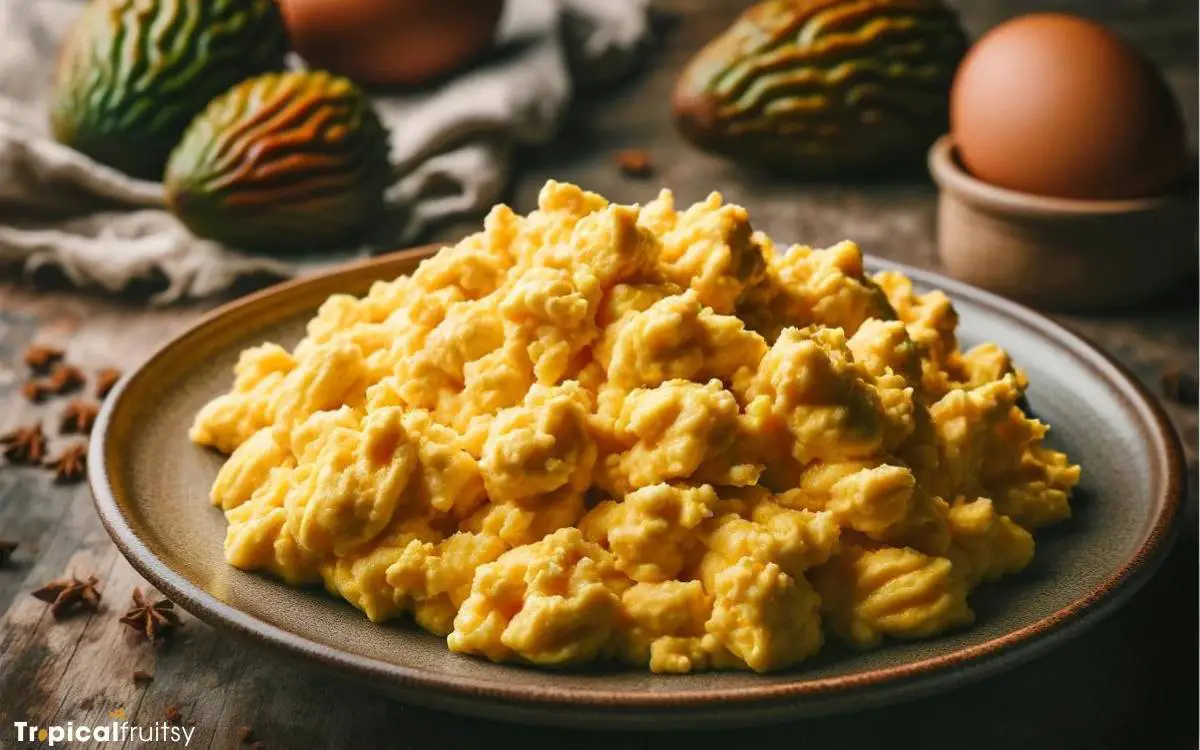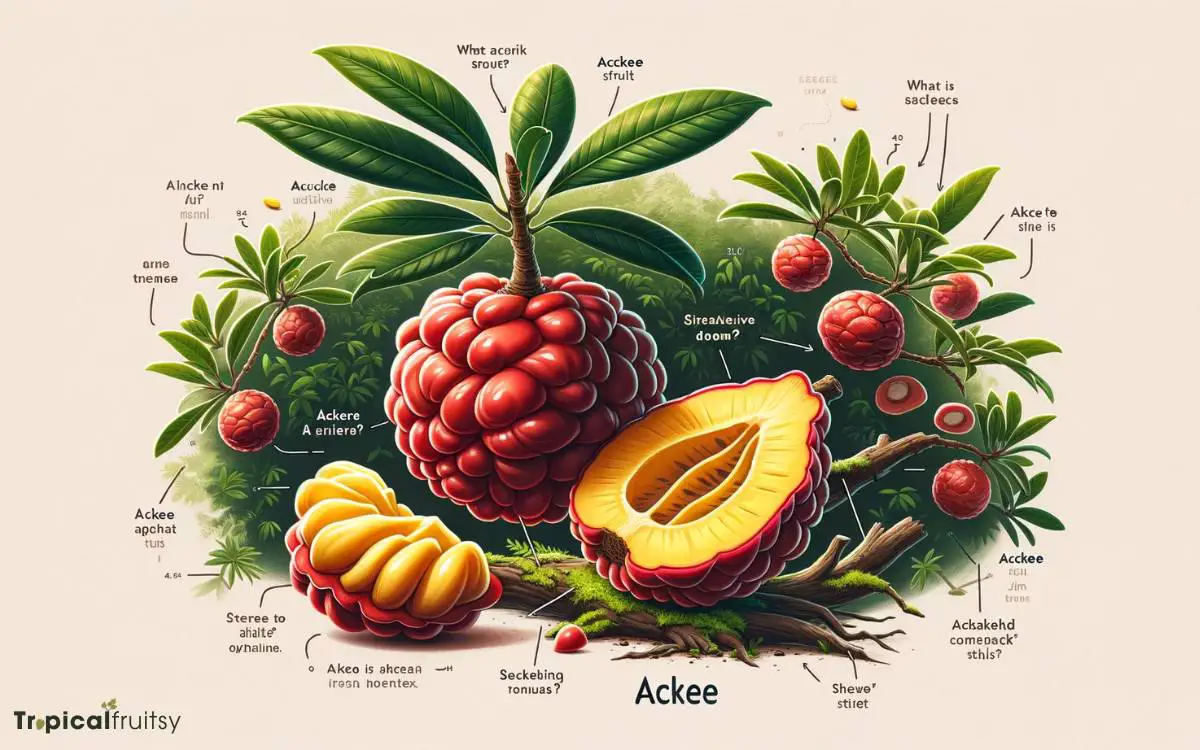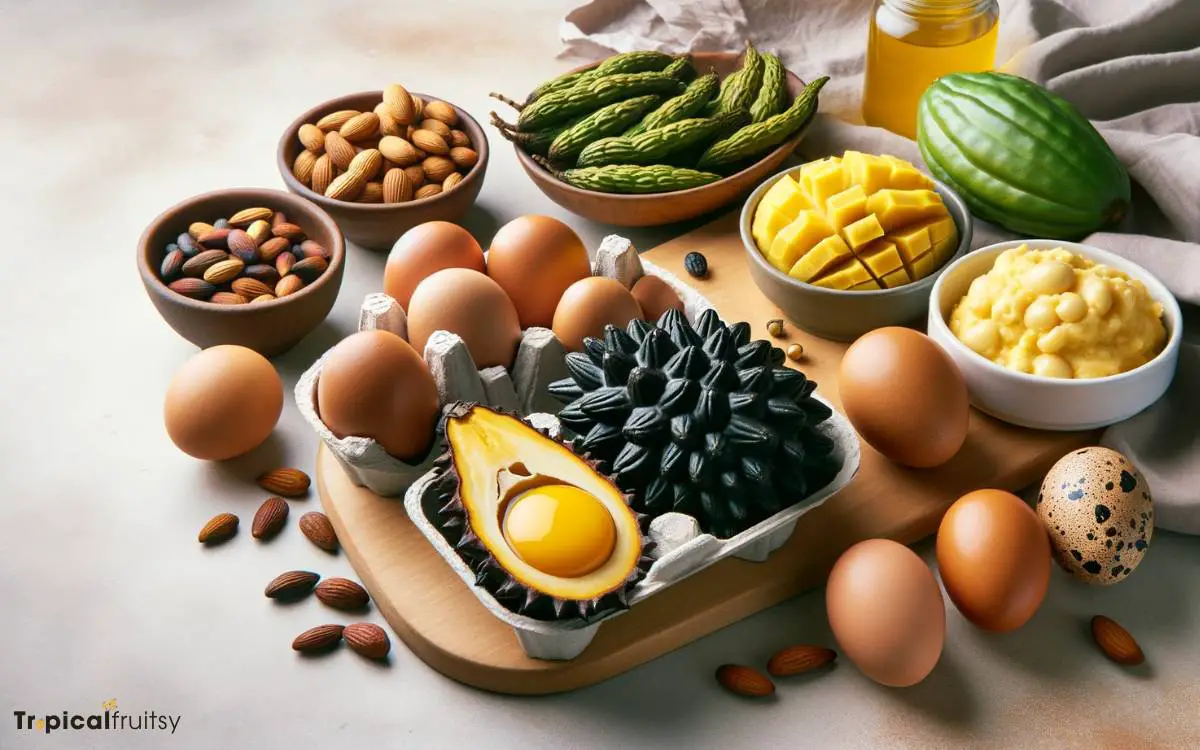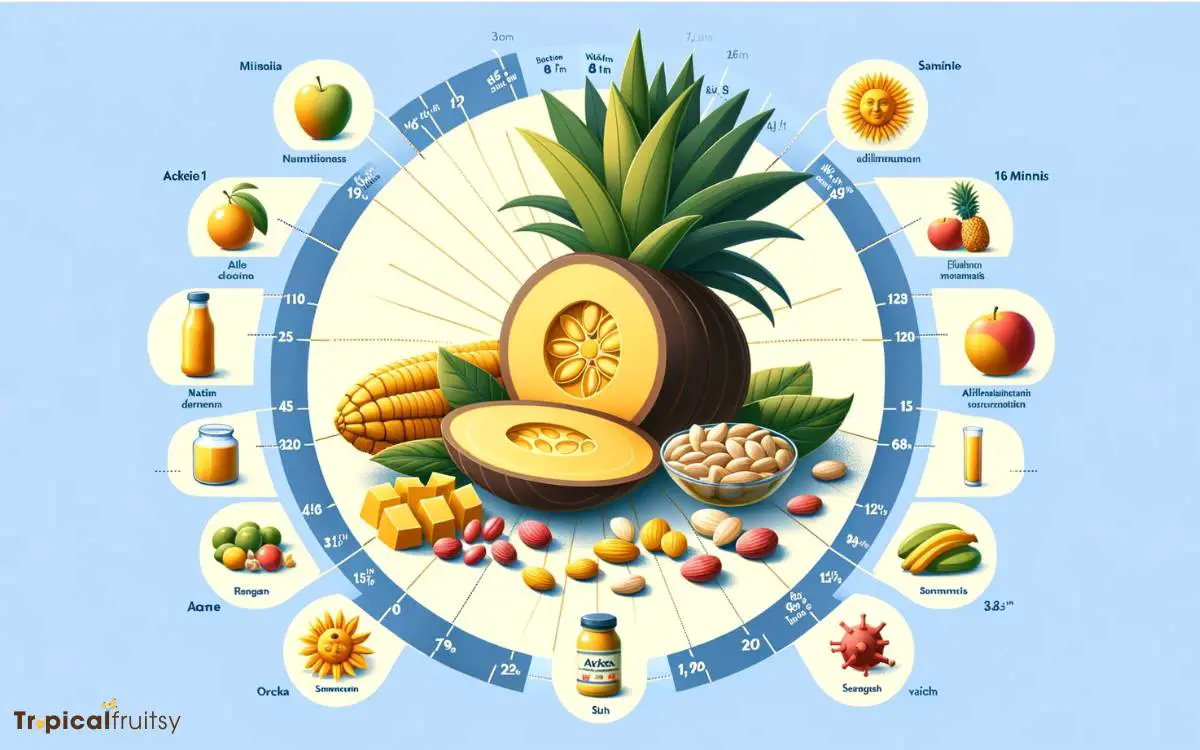Ackee Tastes Like Scrambled Eggs: Savoring the Similarities!
Ackee, the national fruit of Jamaica, presents a curious culinary phenomenon: when prepared, it bears a remarkable resemblance in taste and texture to scrambled eggs.
This fruit, botanically known as Blighia sapida, grows within a bright red pod which, when ripe, naturally splits open to reveal the edible yellow arils inside.
The unique flavor profile of ackee, often described as mild and nutty, coupled with its soft, delicate consistency, has made it a staple in various Caribbean dishes.
While not intrinsically egg-flavored, it is the culinary treatment of ackee that elicits this comparison. Ackee’s preparation involves careful attention, as improper handling can lead to toxicity.
This introduction will explore ackee’s egg-like qualities, its role in Caribbean cuisine, and its emerging popularity as a plant-based alternative to eggs, all while underlining the importance of safe consumption practices.

Key Takeaway
What Is Ackee

Ackee, a staple fruit in Caribbean cuisine, is a tropical evergreen tree’s edible product, renowned for its unique taste and texture, which when cooked, remarkably resembles that of scrambled eggs.
Botanically classified as Blighia sapida, this fruit is native to the tropical regions of West Africa but has been naturalized in Jamaica, where it is now integrally associated with the national dish, ackee and saltfish.
The fruit itself comprises three major components: the outer red skin, the toxic black seeds, and the edible yellow arilli.
Consumption is safe only when the arilli are fully ripe and the fruit has naturally opened, as premature harvesting contains hypoglycin A, a potentially fatal toxin.
Culinary use necessitates meticulous preparation, ensuring all inedible parts are discarded and the edible portions are thoroughly cleaned before cooking.
Ackee’s Egg-like Qualities

Surprisingly often, the creamy texture and mild flavor of cooked ackee are likened to that of scrambled eggs, a comparison that underscores its culinary versatility.
Upon reaching maturity, the ackee’s arilli, the edible portions, exhibit a soft, delicate consistency that, once prepared, bears striking similarity to that of eggs.
The fruit’s subtle taste, lacking an overpowering savoriness, renders it a prime candidate for absorbing spices and seasonings, much like tofu or eggs.
| Quality | Ackee | Scrambled Eggs |
|---|---|---|
| Texture | Creamy, soft | Soft, curd-like |
| Flavor Profile | Mild, buttery, subtly sweet | Mild, often enriched with dairy |
| Culinary Uses | Versatile, absorbs flavors | Versatile, commonly seasoned |
This table delineates the comparative analysis of ackee and scrambled eggs, focusing on their textural and flavor qualities, as well as their adaptability in various dishes.
The Science of Flavor

Flavor perception, a complex interplay between taste and olfactory receptors, is key to understanding why ackee can evoke the sensory experience of scrambled eggs.
The human gustatory system differentiates five basic tastes: sweetness, sourness, saltiness, bitterness, and umami, while the olfactory system captures aroma compounds.
Ackee’s flavor profile may mimic that of scrambled eggs due to specific volatile compounds that stimulate a similar combination of these taste receptors and olfactory pathways.
Analyzing the fruit’s chemical constituents through chromatography and spectrometry reveals the presence of esters, sulfur compounds, and other volatile organic compounds (VOCs) that contribute to its unique taste.
When consumed, these molecules interact synergistically with taste buds and scent receptors, crafting a flavor matrix reminiscent of eggs, thus outlining the scientific foundation of ackee’s egg-like savor.
Preparing Ackee Safely

One must exercise caution when preparing ackee, as the fruit contains toxic hypoglycin A, especially when unripe or improperly cooked. Ackee must only be consumed when the pods turn red and naturally open, revealing the edible flesh.
The inedible parts the seeds and the pink membrane must be meticulously removed to prevent ingestion of the remaining hypoglycin A.
To elucidate the proper preparation techniques, the following table provides a succinct guide:
| Stage | Description |
|---|---|
| Selection | Choose ackee pods that have naturally opened. |
| Cleaning | Remove the black seeds and any traces of the pink membrane. |
| Cooking | Boil the ackee in water for 30 minutes to ensure the reduction of toxins to safe levels. |
This methodical approach is imperative to mitigate the risk of ackee poisoning, guaranteeing a safe culinary experience.
Cooking With Ackee

When incorporating ackee into culinary applications, it is crucial to adhere to established safety protocols to neutralize its potentially toxic components.
The fruit’s unique texture and mild taste create an opportunity for diverse flavor pairings, enhancing its versatility in various dishes.
Analyzing the optimal combinations of spices and ingredients that complement ackee’s egg-like qualities can elevate traditional recipes and inspire innovative gastronomic creations.
Ackee Preparation Safety
To safely incorporate ackee into culinary dishes, it is imperative to thoroughly understand and adhere to proper preparation methods.
Ackee, the national fruit of Jamaica, contains hypoglycin A, a toxin which can lead to Jamaican Vomiting Sickness if consumed improperly. Therefore, meticulous attention to its preparation is a necessity for safe consumption.
| Do’s | Don’ts |
|---|---|
| Wait for the ackee fruit to open naturally | Force open the ackee fruit |
| Discard any ackee that has not opened on its own | Consume unripe ackee |
| Remove the seeds and all traces of the pink membrane | Use the seeds or membrane |
| Ensure the ackee is properly cooked | Eat ackee that is undercooked |
| Purchase canned ackee from reputable sources | Use canned ackee if the can is damaged or swollen |
The analytical approach to ackee preparation centers on these safety protocols, ensuring both the elimination of toxic elements and the preservation of the fruit’s delicate flavor and texture.
Flavor Pairing Suggestions
How does one accentuate the unique, egg-like flavor of ackee in culinary dishes? The key is to thoughtfully pair it with ingredients that complement its delicate taste and creamy texture without overwhelming it.
Here are three pairings that highlight ackee’s versatility:
- Saltfish: This traditional Jamaican pairing relies on the saltiness and flakiness of the fish to contrast with the soft, subtle flavor of ackee.
- Sweet Peppers: Adding diced bell peppers introduces a sweet and slightly tangy element that balances the richness of the fruit.
- Scallions and Thyme: The combination of scallions and thyme brings an aromatic freshness that can elevate the natural flavors of ackee.
As we analyze these pairings, we seamlessly transition into exploring ackee’s role in Caribbean cuisine, where these combinations are not just common but are celebrated.
Ackee in Caribbean Cuisine

We find the savory fruit ackee as a cornerstone in Caribbean cuisine, particularly in Jamaica where it is famously paired with saltfish.
This dish, known as ackee and saltfish, is often considered Jamaica’s national dish and is deeply embedded in the culinary fabric of the region.
The fruit itself must be prepared with care, as unripe ackee contains toxic hypoglycin A. Properly harvested when the fruit’s protective pods turn red and open naturally, ackee’s edible portions are then meticulously cleaned and cooked.
The resultant texture resembles that of scrambled eggs, with a delicate, buttery flavor that complements the saltiness and texture of the rehydrated, sautéed saltfish.
This fusion of flavors encapsulates an essential aspect of Caribbean gastronomy. As we delve deeper into alternative culinary uses, the comparison of ackee to plant-based egg alternatives becomes increasingly relevant.
Plant-Based Egg Alternatives

As the quest for sustainable and health-conscious eating intensifies, plant-based egg alternatives, such as ackee, offer a noteworthy substitute in both nutrition and culinary application.
A comparative analysis of the nutritional content between ackee and traditional eggs reveals significant differences and potential benefits, particularly for those with dietary restrictions.
The culinary versatility of ackee, when prepared correctly, mirrors the texture and flavor profile of scrambled eggs, making it an innovative ingredient in vegan and vegetarian diets.
Nutritional Comparison
Ackee, often touted for its egg-like taste and texture, offers a unique nutritional profile when compared to other plant-based egg alternatives.
To provide a clearer understanding of its nutritional value, here is an analytical comparison:
- Protein Content: While traditional egg substitutes like tofu scramble deliver about 10 grams of protein per half-cup serving, ackee contains a modest 2.9 grams for the same serving size.
- Fat Composition: Ackee has a higher fat content, primarily unsaturated fats, which are considered heart-healthy. This contrasts with lower fat content in alternatives such as chickpea flour.
- Vitamin & Mineral Density: Ackee is rich in vitamin C, fiber, and essential fatty acids, whereas other substitutes may be fortified with vitamins like B12 and minerals such as iron to mimic the nutritional benefits of eggs.
Cooking With Ackee
Experimenting with ackee as a plant-based egg alternative opens up a variety of culinary possibilities, especially for those seeking vegan-friendly options.
Ackee’s naturally mild taste and soft, delicate texture provide an ideal canvas for absorbing spices and flavorings.
When preparing ackee, one must ensure it is fully ripe and properly deseeded to prevent toxicity. The fruit is traditionally boiled or sautéed, mimicking the cooking process of scrambled eggs.
Innovators in vegan gastronomy have capitalized on this similarity, integrating ackee into dishes such as quiches, frittatas, and omelets.
Its compatibility with umami-rich ingredients like nutritional yeast and turmeric further enhances its egg-like profile.
As culinary enthusiasts explore ackee’s potential, they often draw parallels to its flavor and texture, which remarkably resemble that of traditional scrambled eggs.
Flavor & Texture Similarities
Many plant-based egg substitutes lack the unique combination of flavor and texture that ackee provides, setting it apart as a remarkably egg-like alternative for vegan cuisine.
Ackee, when cooked, possesses a delicate, buttery flavor with a soft, creamy texture that closely mimics the experience of scrambled eggs.
The analytical comparison reveals several key areas where ackee’s organoleptic properties align with traditional eggs:
- Flavor Profile: Ackee has a subtle, savory taste with a hint of sweetness, comparable to the gentle umami and slight sulfurous notes found in eggs.
- Mouthfeel: The fruit’s creamy consistency mirrors the moist and fluffy curds of gently cooked scrambled eggs.
- Visual Appearance: Upon cooking, ackee’s pale yellow hue and curd-like structure visually resemble scrambled eggs, enhancing its suitability as a substitute.
This assessment underscores ackee’s potential in vegan gastronomy as a functional and sensory stand-in for eggs.
Would Ackee and Callaloo be a Suitable Substitute for Scrambled Eggs in Recipes?
Looking to add some Caribbean flavors to your breakfast? Consider using ackee and callaloo as a substitute for scrambled eggs in your recipes. These tropical ingredients bring a unique and delicious twist to your morning meal, perfect for your Caribbean flavors exploration.
Ackee’s Nutritional Profile

Nutritionally, ackee is rich in essential fatty acids, dietary fiber, and vitamin C, contributing to its value as a beneficial addition to a balanced diet.
The fruit contains a noteworthy quantity of unsaturated fatty acids, including linoleic, palmitic, and stearic acids, which are pivotal for maintaining heart health and supporting metabolic functions.
Its fibrous content aids in digestion and promotes satiety, while the presence of vitamin C serves as an antioxidant, enhancing immune defense and facilitating collagen synthesis.
Ackee is also a source of complex B vitamins, particularly niacin (vitamin B3), which is integral for converting food into energy.
The mineral composition encompasses calcium, phosphorus, and iron, each playing a vital role in bone density, cellular function, and oxygen transport, respectively. This amalgam of nutrients underscores ackee’s potential as a nutrient-dense food.
Conclusion
Ackee, the national fruit of Jamaica, possesses a unique flavor profile with characteristics resembling scrambled eggs, offering an intriguing option for plant-based diets. Its preparation requires careful attention due to its toxic components when unripe.
When integrated into culinary practices, particularly within Caribbean cuisine, ackee enriches dishes with its versatility and distinctive taste.
Nutritionally, it provides essential fatty acids, highlighting its value beyond its gastronomic novelty.
Ackee’s utilization reflects a growing trend, with 75% of consumers seeking more plant-based foods.






